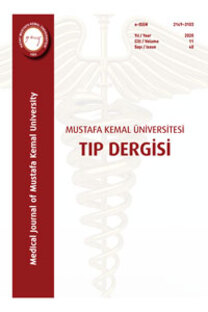FAHR HASTALIĞI: BEŞ OLGU SUNUMU
Ailesel idiopatik bazal ganglion kalsifikasyonu (Fahr hastalığı) bazal ganglionlar, dentat nukleus ve sentrum semiovalede bilateral idiopatik kalsifikasyon birikimleri olarak tanımlanmaktadır.Fahr hastalığında ailesel kalıtımın da rolü vardır, otozomal dominant geçiş gösteren bir hastalık olan Fahr hastalığında otozomal resesif geçişler de bildirilmiştir. Genetik çalışmalarda kromozom 14q’ da bir odak tespit edilmiştir. Semptomlar genelde 40-60’lı yaşlar arasında görülmekle birlikte nadir de olsa çocukluk çağında da görülebilir Hastalık radyolojik, nörolojik, psikiyatrik ve bilişsel bulgular göstermektedir. Hastalık genellikle asemptomatik seyretmekle beraber nörolojik, psikiyatrik ve bilişsel bozukluk eşzamanlı görülebilir. FH için günümüzde tanımlanmış özgün bir tedavi seçeneği bulunmamaktadır. Bu hastalarda tedavi şikayetlere ve eşlik eden patolojilere yönelik olmaktadır. Bu yazıda patolojik bazal ganglion kalsifikasyonu olan beş olgunun literatür eşliğinde görüntüleme bulguları ve nöropsikiyatrik belirtileri tartışılacaktır.
Anahtar Kelimeler:
Fahr hastalığı, bazal ganglion kalsifikasyonu, hipokalsemi
Fahr’s Disease: Five Cases Report
Familial idiopathic basal ganglia calcification (Fahr's disease) is defined as basal ganglia, dentate nucleus and centrum semiovale bilateral idiopathic calcification deposits. Fahr's disease has the role of family participation and Fahr's disease is an autosomal dominant disease, is that autosomal recessive inheritance have been reported. Genetic studies have been identified a focus in chromosome 14q’. Although symptoms are usually seen beetwen decade of 4 and 6, it is rarely seen in childhood. neurological, abnormalities. Although the disease which is often asymptomatic can be seen with neurological, psychiatric simultaneously. There is not specific therapy modalities option for Fahr’s disease defined currently. Treatment is that according for complaints and accompanying pathologies of patient. İn this article will be discussed that imaging findings of with the literature five cases with pathological basal ganglia calcification and neuropsychiatric symptoms
Keywords:
Fahr's disease, basal ganglia calcification, hypocalcemia,
___
- Cartier L, Passig C, Gormaz A, López J. Neuropsychological and neurophysiological features of
- Fahr's disease. Rev Med Chil 2002; 130:1383-1390.
- Fahr T. Idiopathische verkalkung der hirngefa¨be. Centralblatt fu¨r allgemeine Pathologie und
- pathologische. Anatomie 1930; 50:129–133.
- Kobari M, Nogawa S, Sugimoto Y, Fukuuchi Y. Familial idiopathic brain calcification with
- autosomal dominant inheritance. Neurology 1997; 48:645-649.
- Longman C, Whiteford M, Koppel D, Donaldson M, Paterson W, Tolmie J. Craniosynostosis
- associated with intracranial calcification: a novel recessive syndrome. Clin Dysmorphol 2003; 12:215-
- -
- Pilleri G. A case of Morbus Fahr(nonarteriosclerotic, idiopathic intracerebral calcification of the
- blood vessels) in three generations. An clinico-anatomical contribution. Psychiatr Neurol (Basel)
- ; 152:43-58.
- Billard C, Dulac O, Bouloche J, Echenne B, Lebon P, Motte J, Robain O, Santini JJ.
- Encephalopathy with calcifications of the basal ganglia in children: a reappraisal of Fahr's syndrome
- with respect to 14 new cases. Neuropediatrics 1989; 20:12-19.
- Geschwind DH, Loginov M, Stern JM. Identification of a locus on chromosome 14q for idiopathic
- basal ganglia calcification (Fahr disease). Am J Hum Genet 1999; 65:764-772.
- Brodaty H, Mitchell P, Luscombe G, Kwok JJ, Badenhop RF, McKenzie R, Schofield PR. Familial
- idiopathic basal ganglia calcification (Fahr's disease) without neurological, cognitive and psychiatric
- symptoms is not linked to the IBGC1 locus on chromosome 14q. Hum Genet 2002; 110:8-14.
- Menkes JH, Sarnat HB. Child Neurology. 6th ed, Philadelphia, Lippincott Williams&Wilkins 2000;
- -184.
- Förstl H, Krumm B, Eden S, Kohlmeyer K. Neurological disorders in 166 patients with basal
- ganglia calcification: a statistical evaluation. J Neurol 1992; 239:36-38.
- Windeck R, Menken U. Basal ganglia calcification in pseudohypoparathyroidism typeII. Clin
- Endocrinol 1981; 15:57-63.
- Babbitt DP, Tang T, Dobbs J, Berk R. Idiopathic familial cerebrovascular ferrocalcinosis (Fahr's
- disease) and review of differential diagnosis of intracranial calcification in children. Am J Roentgenol
- Radium Ther Nucl Med 1969; 105:352-358.
- Lam JSP, Fong SYY, Yiu GC, Wing YK. Fahr’s disease: a differential diagnosis of frontal lobe
- syndrome. Hong Kong Med J 2007; 13:75-77.
- Lester J, Zuniga C, Diaz S, Rugilo C, Micheli F. Diffuse intracranial calcinosis: Fahr disease. Arch
- Neurol 2006; 63:1806-1807.
- Konig P. Psychopathological alterations in cases of symmetrical basal ganglia sclerosis. Biol
- Psychiatry 1989; 25:459-468.
- ISSN: 2149-3103
- Yayın Aralığı: Yılda 3 Sayı
- Başlangıç: 2010
- Yayıncı: Hatay Mustafa Kemal Üniversitesi Tıp Fakültesi Dekanlığı
Sayıdaki Diğer Makaleler
FAHR HASTALIĞI: BEŞ OLGU SUNUMU
İsmail KARTAL, Musa ŞAHPOLAT, M. KOKAÇYA, Nesrin ATÇI
VASO-OKLUSİV KRİZ ORAK HÜCRELİ ANEMİDE HEMATOLOJİK PARAMETRELERİ NASIL DEĞİŞTİRİR?
Can ACIPAYAM, Sadık KAYA, Gönül OKTAY, Gül İLHAN
S. BAŞARSLAN, Cüneyt GÖÇMEZ, Kağan KAMAŞAK
ÇOCUKLARDA SUDA BOĞULMALARA GÜNCEL YAKLAŞIMLAR
Vefik ARICA, Hüseyin DAĞ, Sibel KALÇIN, Sevilay KÖK, Kübra BÖLÜK, Murat DOĞAN
